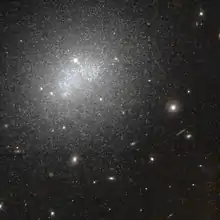| NGC 6789 | |
|---|---|
 Hubble Space Telescope image of NGC 6789 | |
| Observation data (J2000 epoch) | |
| Constellation | Draco |
| Right ascension | 19h 16m 41s[1] |
| Declination | +63° 58′ 23″[1] |
| Redshift | −0.000470[2] |
| Heliocentric radial velocity | −141 ± 9 km/s[2] |
| Distance | 12 Mly (3.6 Mpc)[3] |
| Apparent magnitude (B) | 13.76[1] |
| Characteristics | |
| Type | Im[2] |
| Other designations | |
| NGC 6789,MCG+11-23-001, LEDA 63000[1] | |
NGC 6789 is a void[4] irregular galaxy in the constellation Draco. It was discovered by Lewis Swift on Aug 30, 1883.[5] It is located within the Local Void, a region of space with far fewer galaxies than its surroundings.[4]
NGC 6789 is the nearest blue compact dwarf (BCD) galaxy to the Milky Way. It is chemically homogeneous and relatively metal-poor.[3]
See also
References
- 1 2 3 4 "NGC 6789". SIMBAD. Centre de données astronomiques de Strasbourg. Retrieved 19 June 2019.
- 1 2 3 "NASA/IPAC Extragalactic Database". ned.ipac.caltech.edu. Retrieved 19 June 2019.
- 1 2 García-Benito, R.; Pérez-Montero, E. (2012). "Auto-consistent metallicity and star formation history of the nearest blue compact dwarf galaxy NGC 6789". Monthly Notices of the Royal Astronomical Society. 423 (1): 406–421. arXiv:1203.2186. Bibcode:2012MNRAS.423..406G. doi:10.1111/j.1365-2966.2012.20885.x. S2CID 119163529.
- 1 2 Lelli, Federico; Verheijen, Marc; Fraternali, Filippo (2014). "The triggering of starbursts in low-mass galaxies". Monthly Notices of the Royal Astronomical Society. 445 (2): 1694–1712. arXiv:1409.1239. Bibcode:2014MNRAS.445.1694L. doi:10.1093/mnras/stu1804.
- ↑ Seligman, Courtney. "New General Catalog Objects: NGC 6750 - 6799". New General Catalog Objects: NGC 6750 - 6799. Retrieved 19 June 2019.
External links
 Media related to NGC 6789 at Wikimedia Commons
Media related to NGC 6789 at Wikimedia Commons- NGC 6789 on WikiSky: DSS2, SDSS, GALEX, IRAS, Hydrogen α, X-Ray, Astrophoto, Sky Map, Articles and images
This article is issued from Wikipedia. The text is licensed under Creative Commons - Attribution - Sharealike. Additional terms may apply for the media files.